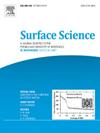Dimer adsorption and identification for various spiropyran-based molecular switches using Molecular Mechanics calculations
IF 1.8
4区 化学
Q3 CHEMISTRY, PHYSICAL
引用次数: 0
Abstract
In this study we have systematically investigated the adsorption geometries and energies of various merocyanine/spiropyran molecules on NaCl. The molecules are closed-ring spiropyran molecules with various side groups which can be transferred into open-ring merocyanine molecules. These isomers act as molecular switches which can be triggered by different external stimuli. The underlying substrate for this study is a two-layer film of the ionic insulator sodium chloride (NaCl). Adsorption of the spiropyran molecules is mostly driven by a competition between the sets of aromatic rings being able to find configurations close to the surface which leads overall to more preferable adsorption energies. On the other hand, since the merocyanine isomer as T-conformers have a generally flat geometry, they will be able to orient themselves nearly parallel to the substrate. This leads to higher binding energies for T-conformer compared to C-conformers, which due to steric effects cannot adsorb in a flat configuration. The beginning of film growth for these molecules starts with dimer formation which can be in parallel or anti-parallel geometries. In general, the anti-parallel configurations lead to higher binding energies when oppositely charged moieties of the molecules can interact through Coulomb forces. Comparing the calculated dimer configurations to experimentally observed dimers allows us to identify the particular conformers for each merocyanine molecule which might be energetically more favorable upon adsorption on the substrate. For two molecules with similar side groups, namely benzo and naphtho merocyanine, the so-called CTT and TTC conformers form dimers with highest binding energies, whereas for nitro and methoxy merocyanine, which have a common nitro side group, the dimers with highest binding energies consist of CTC and TTT conformers.
基于分子力学计算的各种螺吡喃分子开关的二聚体吸附和鉴定
在本研究中,我们系统地研究了各种merocyanine/spiropyran分子在NaCl上的吸附几何形状和吸附能。这些分子是具有各种侧基的闭环螺吡喃分子,这些侧基可以转化为开环merocyanine分子。这些异构体起着分子开关的作用,可以被不同的外部刺激触发。本研究的底层衬底是离子绝缘体氯化钠(NaCl)的两层薄膜。螺吡喃分子的吸附主要是由芳香环之间的竞争驱动的,它们能够找到靠近表面的构型,从而产生更有利的吸附能。另一方面,由于作为t形构象的merocyanine异构体通常具有平坦的几何形状,它们将能够定向自己几乎平行于底物。这导致与c -构象相比,t -构象的结合能更高,c -构象由于空间效应不能在平面构型中吸附。这些分子的膜生长开始于二聚体的形成,二聚体可以是平行的或反平行的几何形状。一般来说,当分子中带相反电荷的部分通过库仑力相互作用时,反平行构型会导致更高的结合能。将计算的二聚体构型与实验观察到的二聚体进行比较,我们可以确定每个merocyanine分子的特定构象,这些构象可能在能量上更有利于在底物上吸附。对于两个侧基相似的分子,即苯并和萘merocyanine,所谓的CTT和TTC构象形成了结合能最高的二聚体,而对于硝基和甲氧基merocyanine,具有共同的硝基侧基,具有最高结合能的二聚体是CTC和TTT构象。
本文章由计算机程序翻译,如有差异,请以英文原文为准。
求助全文
约1分钟内获得全文
求助全文
来源期刊

Surface Science
化学-物理:凝聚态物理
CiteScore
3.30
自引率
5.30%
发文量
137
审稿时长
25 days
期刊介绍:
Surface Science is devoted to elucidating the fundamental aspects of chemistry and physics occurring at a wide range of surfaces and interfaces and to disseminating this knowledge fast. The journal welcomes a broad spectrum of topics, including but not limited to:
• model systems (e.g. in Ultra High Vacuum) under well-controlled reactive conditions
• nanoscale science and engineering, including manipulation of matter at the atomic/molecular scale and assembly phenomena
• reactivity of surfaces as related to various applied areas including heterogeneous catalysis, chemistry at electrified interfaces, and semiconductors functionalization
• phenomena at interfaces relevant to energy storage and conversion, and fuels production and utilization
• surface reactivity for environmental protection and pollution remediation
• interactions at surfaces of soft matter, including polymers and biomaterials.
Both experimental and theoretical work, including modeling, is within the scope of the journal. Work published in Surface Science reaches a wide readership, from chemistry and physics to biology and materials science and engineering, providing an excellent forum for cross-fertilization of ideas and broad dissemination of scientific discoveries.
 求助内容:
求助内容: 应助结果提醒方式:
应助结果提醒方式:


